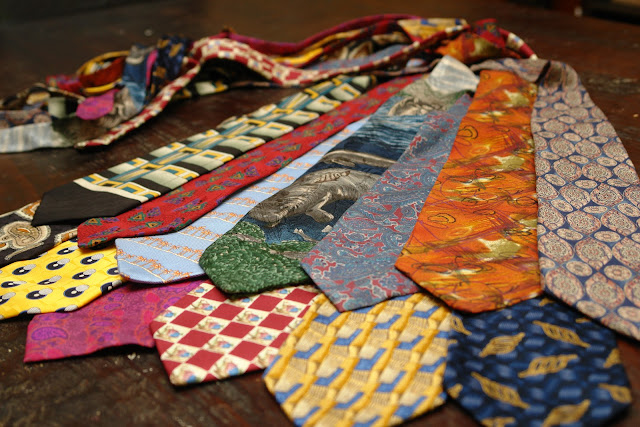Silk Dyed Easter Eggs
>> Tuesday, April 19, 2011
This year I tried out silk dyed eggs. I saw this technique last year after I had already dyed marbelized eggs. Drats! But then again maybe waiting a year was worth it. I'll definitely be doing this process again.
Here's a list of all you'll need to do the same project:
- large uncooked eggs
- 100% silk ties, scarves, shirts, etc.
- 100% cotton cloth squares
- rubber bands, twist ties or string
- non-reactive pot to boil eggs (enamel, glass or stainless steel)
- vinegar
- patience
My kids and I set off to the thrift stores in late March in search of silk ties. I let the kids pick whatever tickled their fancy as long as it had a 100% silk label and was $1 or less.
Here's our bounty of ties.
I also needed white cotton to wrap the eggs in after they were wrapped in the silks. I found a white 100% cotton queen size sheet at one of the same thrift stores and it was half price pink day so I scored it for only $1.29. And there's ample cotton left after cutting my squares for all kinds of other crafty cotton needs.
Next you have to take apart the ties, remove their linings and cut them into squares large enough to cover the egg. I was able to get three pieces from each tie large enough for the eggs.
Now wrap your raw eggs with the printed side of the silk facing in. Wherever your fabric wrikles there will be a twist to the pattern. Try to make sure your eggs are completely covered. Any portion of the egg not touching silk will remain white. With most eggs I rolled it in the silk then twisted the ends like candy and folded the ends behind, securing with a rubber band.
Other eggs I placed standing in the square of silk and pulled all the material up to the top and secured with one rubber band like the egg had a high ponytail. Another tip: wet your silks as you wrap. Wet silk adheres and smooths onto the eggs easier.
After wrapped in silk you need to wrap each egg in the white cotton. I used the same candy twist and fold back with one rubber band technique on these.
Place them gently in your non-reactive pot and cover with water and 1/3 cup of vinegar. Bring the eggs to a boil then simmer at least 40 minutes. The longer they simmer the more color can transfer. I was hesitant to go past 40 minutes fearing my eggs would break like overcooked hardboiled eggs are apt to do. However, none of my eggs were cracked. I'm guessing the tight wrap prevents that and I'm going to attempt this next time with a much longer simmer and then also leave them in the water perhaps even an hour after I turn off the heat.
I would not eat these eggs. The long cook time pretty much ensures they would not be tasty. Blech! You could do this same technique with blown eggs. However, I can't blow an egg. It leaves me light headed and with sore cheeks. Any tips from professional egg blowers are welcome! Remember if you do use blown eggs you'll need to find a way to weight them down with a non-reactive object so they don't float to the top.
Take them out of the water and let them completely cool before unwrapping. Don't rush this. The one that I unwrapped early because I just couldn't stand it was far more muted than its partner from the same cut of tie opened two hours later.
Before I get to the big reveal who wants to know how this whole process works? If you don't, simply skip ahead to the next pretty picture. Otherwise hold on and I'll give you what I know. And if you're reading this and realize I have my science wrong, please tell me. Okay, here goes the geek speak...silk is a natural protein fiber since it's made by those little wormy guys. Eggs shells are also a protein material made by those little chicken girls. The only way to dye protein fibers is with acid dyes. Ergo the dye used in silks would also color egg shells. Follow so far? You add the vinegar because vinegar is also an acid and increases the acidity of the water allowing the color to become more intense and better bind to the egg's protein shell. WAKE UP! I'm almost done. What I'm a bit unclear on is the cotton. I'm going out on a limb here but I think that since the cotton is a plant, not protein, fiber it does not readily absorb acid dyes. So it acts as a bit of a barrier to contain the transfer of the dye from silk to egg and not just out into the water. Okay, I'm done now. Do you feel edu-ma-cated?
Moving on to the fun stuff...unwrapping the eggs! It was a beautiful day here so we headed outside to sit on the new stage my man built the kids in the backyard to unveil our creations.
You just never know how much color and pattern would carry from each tie. They all varied I supposed based on the age of the tie or quality of dyes used. I really have no idea why some worked and some didn't. That's a total guess. But it sounds good.
The kids were each having a blast discovering each new design.
So much fun that when Princess Fierce's friend walked over to play she wanted to share and let her unwrap too.
Pretty sure their faces say everything here.
Some of the colors came through brilliantly.
Our one and only dud of a tie. And we really thought the colors on this one would've been vibrant.
I found a Charlie Brown tie in the basement we added last minute to our bounty and Thing Two could not wait to see if it worked.
And it did! This rocks and opens up a whole new world of types of ties I'll be looking for over the next year.
The kids also called over their friend next door to join the unwrapping party.
Love his expression at unwrapping a purple egg for the girls.
Even our dog enjoyed watching the process.
Thing One unwrapped the last egg. He was not too thrilled it was a hot pink egg.
And now here's the entire set of eggs with their silks:
The manatee with her baby is my absolute favorite! That's the only one I did on a blown egg and I think I'm going to transform it into a Christmas ornament after Easter is over.
So gather your old silks and get dyeing!
I'm linking this up in some of these link parties:
























































